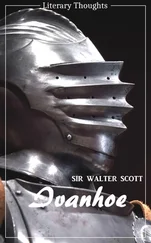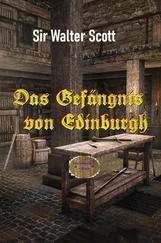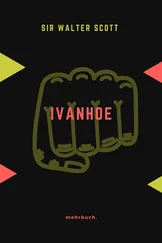Walter Scott - Ivanhoe
Здесь есть возможность читать онлайн «Walter Scott - Ivanhoe» — ознакомительный отрывок электронной книги совершенно бесплатно, а после прочтения отрывка купить полную версию. В некоторых случаях можно слушать аудио, скачать через торрент в формате fb2 и присутствует краткое содержание. Жанр: Исторические приключения, на английском языке. Описание произведения, (предисловие) а так же отзывы посетителей доступны на портале библиотеки ЛибКат.
- Название:Ivanhoe
- Автор:
- Жанр:
- Год:неизвестен
- ISBN:нет данных
- Рейтинг книги:4 / 5. Голосов: 1
-
Избранное:Добавить в избранное
- Отзывы:
-
Ваша оценка:
- 80
- 1
- 2
- 3
- 4
- 5
Ivanhoe: краткое содержание, описание и аннотация
Предлагаем к чтению аннотацию, описание, краткое содержание или предисловие (зависит от того, что написал сам автор книги «Ivanhoe»). Если вы не нашли необходимую информацию о книге — напишите в комментариях, мы постараемся отыскать её.
Ivanhoe — читать онлайн ознакомительный отрывок
Ниже представлен текст книги, разбитый по страницам. Система сохранения места последней прочитанной страницы, позволяет с удобством читать онлайн бесплатно книгу «Ivanhoe», без необходимости каждый раз заново искать на чём Вы остановились. Поставьте закладку, и сможете в любой момент перейти на страницу, на которой закончили чтение.
Интервал:
Закладка:
3 (p. 35) King Oberon: Oberon is the fairy king in Shakespeare’s A Midsummer Night’s Dream, but Wamba is certainly referring to a text more contemporary (although still anachronistic) to the setting of Ivanhoe, namely Huon of Bordeaux, a thirteenth-century romance.
CHAPTER II
1 (p. 35) epigraph: The lines are from Chaucer’s Canterbury Tales: the “General Prologue,” I:165-172.
2 (pp. 38-39) natives of some distant Eastern country: [Author’s note] Negro Slaves. The severe accuracy of some critics has objected to the complexion of the slaves of Brian de Bois-Guilbert, as being totally out of costume and propriety. I remember the same objection being made to a set of sable functionaries whom my friend, Mat Lewis, introduced as the guards and mischief-doing satellites of the wicked Baron in his Castle Spectre. Mat treated the objection with great contempt, and averred in reply, that he made the slaves black in order to obtain a striking effect of contrast, and that, could he have derived a similar advantage from making his heroine blue, blue she should have been.
I do not pretend to plead the immunities of my order so highly as this; but neither will I allow that the author of a modern antique romance is obliged to confine himself to the introduction of those manners only which can be proved to have absolutely existed in the times he is depicting, so that he restrain himself to such as are plausible and natural, and contain no obvious anachronism. In this point of view, what can be more natural than that the Templars, who, we know, copied closely the luxuries of the Asiatic warriors with whom they fought, should use the service of the enslaved Africans whom the fate of war transferred to new masters? I am sure, if there are no precise proofs of their having done so, there is nothing, on the other hand, that can entitle us positively to conclude that they never did. Besides, there is an instance in romance.
John of Rampayne, an excellent juggler and minstrel, undertook to effect the escape of one Audulf de Bracy, by presenting himself in disguise at the court of the king, where he was confined. For this purpose, he stained “his hair and his whole body entirely as black as jet, so that nothing was white but his teeth,” and succeeded in imposing himself on the king as an Ethiopian minstrel. He effected, by stratagem, the escape of the prisoner. Negroes, therefore, must have been known in England in the dark ages. gw
3 (p. 40) covereth a multitude of sins: See the Bible, 1 Peter 4:8.
4 (p. 43) Knights Templars: The order, founded in 1118 during the Crusades, takes its name from the Temple of Solomon in Jerusalem, where the knights were headquartered. Their initial mission was to protect Christian pilgrims on their journeys to the Holy Land, but with the blessing of the pope, the order quickly spread throughout western Europe, gaining enormous wealth and political influence.
5 (p. 44) Hereward… Heptarchy: The Anglo-Saxon hero Hereward’s resistance to William the Conqueror significantly postdates the demise of the Heptarchy, the name given to the seven original Anglo-Saxon kingdoms before the Danish invasions beginning in the seventh century.
6 (p. 45) houris of old Mahound’s paradise: “Mahound” is a derogatory variation on “Muhammad”; the Prior is referring to a commonly held Western belief that the Koran promises virgins in paradise to the “blessed” who die in the name of Islam.
CHAPTER III
1 (p. 48) epigraph: The lines are from James Thomson’s long poem Liberty (1735-1736; 4.668-670).
2 (p. 52) “I might even have made him one of my warders”: [Author’s note] Cnichts. The original has cnichts, by which the Saxons seem to have designated a class of military attendants, sometimes free, sometimes bondsmen, but always ranking above an ordinary domestic, whether in the royal household or in those of the aldermen and thanes. But the term cnicht, now spelt knight, having been received into the English language as equivalent to the Norman word chevalier, I have avoided using it in its more ancient sense, to prevent confusion.—L. T.
3 (p. 54) the most odiferous pigments: [Author’s note] Morat and Pigment. These were drinks used by the Saxons, as we are informed by Mr. Turner. Morat was made of honey flavoured with the juice of mulberries; pigment was a sweet and rich liquor, composed of wine highly spiced, and sweetened also with honey; the other liquors need no explanation.—L. T.
CHAPTER IV
1 (p. 55) epigraph: The lines, slightly altered, are from Pope’s translation (1725-1726; 20.314-317, 322-324).
2 (p. 56) the horns of the altar: See the Bible, Psalms 118:27.
3 (p. 61) a truce with Saladin: Saladin was the Western name given to the Sultan of Egypt and Syria whose attack on Christian Jerusalem in 1187 prompted the Third Crusade (1189-1192), in which Richard I participated. After mixed success, and never reaching Jerusalem itself, Richard negotiated a truce with Saladin in 1192.
CHAPTER V
1 (p. 62) epigraph: The quotation is from Shylock’s famous speech from The Merchant of Venice (act 3, scene 1). Scott borrowed much from Shakespeare, most notably the stagy, pseudo-medieval language spoken by the characters in Ivanhoe. With the choice of this epigraph, he explicitly holds up Shylock as his model for Isaac.
2 . (p. 65) “ all the babble of the fabulous Sir Tristrem: [Author’s note] Sir Tristrem. There was no language which the Normans more formally separated from that of common life than the terms of the chase. The objects of their pursuit, whether bird or animal, changed their name each year, and there were a hundred conventional terms to be ignorant of which was to be without one of the distinguishing marks of a gentleman. The reader may consult Dame Juliana Berners’s book on the subject. The origin of this science was imputed to the celebrated Sir Tristrem, famous for his tragic intrigue with the beautiful Ysolte. As the Normans reserved the amusement of hunting strictly to themselves, the terms of this formal jargon were all taken from the French language.
3 (p. 65) Northallerton … the Holy Standard: The English defeated the Scots in a famous battle on Cowton Moor, near Northallerton, in 1138, at which the English carried the banners of Saints Peter, John, and Wilfred.
4 (p. 66) Knights Hospitallers: A militant order of monks founded in 1120 to superintend the Christian Hospital in Jerusalem. Their importance as a military force grew with the Crusades, and by the late twelfth century they were the Knights Templars’ principal rivals.
5 (p. 66) St. John-de-Acre: A strategically important port in northern Israel taken by Saladin in 1187, St. John-de-Acre was recaptured by the Crusaders four years later. The legend of a victory tournament began with the romance Richard Coeur de Lion (see note 15 to the Dedicatory Epistle, above), which is also Scott’s source for significant details of the Ashby tournament in Ivanhoe.
CHAPTER VI
1 (p. 62) epigraph: The lines are from Shakespeare’s The Merchant of Venice (act 1, scene 3).
2 (p. 76) misery of Lazarus: It would be unlikely for a medieval Jew to refer to the New Testament (Luke 16:20-21), the parable of the poor man at the rich man’s gate. A further irony is that Isaac more resembles the rich man in the story than the beggar.
3 (p. 79) the Jews of this period: Scott significantly underplays the extent of persecution of the Jews at this time. Brought to England with the Normans, they were given royal protection by the Conqueror in return for enormous loans, but their situation in England deteriorated significantly under Richard I, whose coronation day itself was marred by pogroms. Isaac and Rebecca’s departure at the end of the novel is an implicit signal of how intolerable the combination of extortion and violence had become for the Jews in twelfth-century England. They were officially expelled in 1290 by Edward I and not readmitted until 1655.
Читать дальшеИнтервал:
Закладка:
Похожие книги на «Ivanhoe»
Представляем Вашему вниманию похожие книги на «Ivanhoe» списком для выбора. Мы отобрали схожую по названию и смыслу литературу в надежде предоставить читателям больше вариантов отыскать новые, интересные, ещё непрочитанные произведения.
Обсуждение, отзывы о книге «Ivanhoe» и просто собственные мнения читателей. Оставьте ваши комментарии, напишите, что Вы думаете о произведении, его смысле или главных героях. Укажите что конкретно понравилось, а что нет, и почему Вы так считаете.








